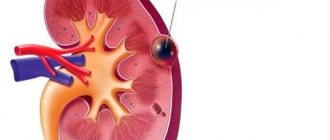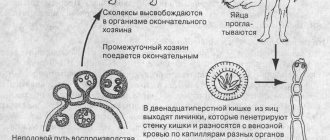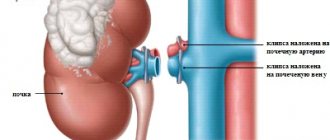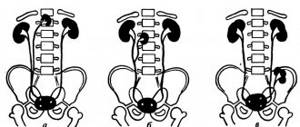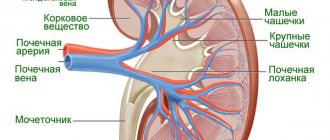Filter organ
Our kidneys are a paired organ that filters the blood and removes excess water from the body, and with it harmful substances.
Normally, a person has two kidneys, they are located on both sides of the spinal column, have the shape of beans, dimensions are approximately 10–12 cm in length and 5–6 cm in width, an adult kidney weighs from 120 to 300 g. Kidneys secrete on average 1–1.5 liters of urine per day.
Scientific and technological progress has brought many benefits to humanity, but it has changed our way of life and nutrition, and worsened the environmental situation on the planet. Chemicals, which are used in huge quantities in industry and agriculture, settle on the soil, enter groundwater and with food grown on this soil, and with this water they penetrate into our bodies. Our kidneys have to cope with the additional chemical load.
More than 500 million people worldwide (about one in ten adults on the planet) have various kidney diseases. Among them:
● salt deposition and stone formation. Small stones (sand) pass through the ureters, causing almost no harm. Larger ones can get stuck in the urinary tract and cause excruciating pain. Or remain in the renal pelvis, disrupting the functioning of the kidneys;
● renal failure . It can be caused by infection, atherosclerosis, hypertension, and diabetes. In case of chronic renal failure, hemodialysis (blood purification using an “artificial kidney”) or a donor kidney transplant is necessary;
● pyelonephritis . Infectious inflammation of the kidneys. The causative agents are Escherichia coli, staphylococcus, Klebsiella, Proteus, enterococcus, streptococcus... The disease is caused by inflammatory processes in the genitals, in the urinary system, in the oral cavity, from these sources the infection enters the kidneys. Another route is through the ureter from the urinary tract. Women are more likely to suffer from pyelonephritis: their anatomical structure is more vulnerable to infection;
● hydronephrosis . Complete or partial distension of the renal pelvis by urine due to its poor outflow. Causes of hydronephrosis: kidney stones, ureteral diseases, tumor, kinking of the ureter.
Every year we see a 17% increase in the number of kidney diseases, which is 3 times higher than the global average.
General view and structure of the kidney: 1 - general view of the human left kidney;
2 - adrenal gland; 3 - gate of the kidney; 4 - renal artery; 5 - renal vein; 6 - ureter; 7 - incision through the kidney; 8 - renal pelvis; 9 - renal cortex; 10 - renal medulla.
Why does the body need kidneys?
The main task of the kidneys is to effectively filter waste products and remove them from the body.
In addition, the kidneys are a factory of some important hormones and vitamins. Every day, the kidneys filter about 1,500 liters of blood, extracting from it the nutrients, water and waste products that the body needs to rid itself of that are necessary for its own continuous functioning.
In the form of urine, “garbage” is removed from the body in a volume of 500 ml to 10 liters daily. Together with the "garbage can" bladder, the kidneys form an efficient, self-contained and compact, perfect excretory system - a waste disposal system that requires minimal "operating costs" and "maintenance".
Figures and facts
About 25 km is the total length of the capillaries in the kidney.
35 times a day, all the blood passes through the kidneys, cleansing itself of toxins.
More than 30 thousand kidney transplant operations are performed annually in the world.
The average kidney of a healthy adult weighs 180 g. If a person constantly sleeps on his left side, stones are much more likely to occur in the left kidney and vice versa.
About 3% of all cases of high blood pressure are the result of kidney infections or nephritis.
People who, due to their occupation, move little (pilots, sailors, submariners) or lose a significant amount of fluid during work (metallurgists in hot shops, cooks, confectioners) are more susceptible to urolithiasis than others.
Each kidney contains about 1 million individual filter elements. Its filtration surface reaches 1.5 m2.
Every minute, 1.2 liters of blood passes through the kidneys, from which 1/8 liter of urine is distilled.
Sleep well and have enough time
When you are in the realm of Morpheus, your kidney tissues are restored.
If you don't get enough sleep, you can quickly develop kidney failure.
Be careful with coffee. Excessive consumption of caffeine will not lead to anything good.
When there is a lot of caffeine in the body, the blood begins to thicken. And the body removes the accumulated fluid at an accelerated pace. Dehydration causes kidney pain. By the way, also drink tea in moderation.
On a powder bud
Most of us associate hypertension with cardiovascular diseases. And he does not suspect renal hypertension.
Signs of illness. With ordinary hypertension, blood pressure most often rises in response to emotional or physical stress. With renal disease, high blood pressure remains constant. And at the same time, as a rule, the lower - diastolic - pressure increases.
The disease often chooses young and able-bodied men as its victims.
Trigger mechanism. Pressure is a derivative of the interdependent work of the heart, kidneys and vascular tone. In the process of evolution, the kidneys assumed the function of a pressure regulator. If for any reason this mechanism is disrupted and the pressure drops, renin is released into the blood, a specific substance that is converted into angiotensin, which has a vasoconstrictor effect and stimulates the production of aldesterone, an adrenal hormone that retains sodium and water in the body. A situation arises in which the level of circulating blood does not correspond to the volume of the vascular bed.
The cause of renal hypertension can be any kidney disease: narrowing of the renal artery (due to atherosclerosis or congenital abnormality of the vessel), polycystic disease (a hereditary disease that compresses the kidney tissue), nephropathy (a sad consequence of diabetes) and even pyelonephritis, which causes serious changes in the structure of the kidney itself.
A difficult legacy. A regular increase in diastolic pressure is fraught with cerebrovascular accidents, hemorrhages in the retina, and severe damage to the arteries. In “malignant” hypertensive patients, the properties of the blood change (it becomes more viscous), lipid metabolism is disrupted, the elasticity of blood vessels is lost, which, like corrosion, are affected by atherosclerosis and require increasing efforts of the heart.
Fresh current. Until recently, renal hypertension was treated with handfuls of drugs, which did not always lead to the desired effect. Doctors were able to achieve a truly positive result only in 4% of cases. The reason is the complexity of the mechanism for regulating renal pressure. And a lot of adverse reactions to antihypertensive drugs.
But now doctors use a unique and very effective method of treating hypertension, which allows, without surgery or anesthesia, to change the direction of blood flow and reduce the amount of hormones that provoke a jump in blood pressure and vascular spasm. The essence of this method is a painless puncture of the femoral vein, through which, under X-ray control, miniature Teflon-coated coils are inserted into the central veins of the adrenal glands. Thanks to this manipulation, the blood flow in the adrenal glands changes, excessively produced aldosterone and other stress hormones are discharged into the liver, where they are destroyed, relieving hypertensive patients from suffering for many, many years.
Important. In order to find out whether your hypertension has a renal component, donate blood for hormones, conduct magnetic resonance imaging of the adrenal glands, and, if necessary, angiography of the renal arteries.
Treat cystitis correctly
If you didn’t take care and got sick, it’s not enough to drink weed, warm up and take a steam bath. Be sure to see a doctor and take a urine test to make sure it is cystitis. After determining the diagnosis, the doctor will prescribe treatment. As a rule, cystitis is caused by a bacterial infection, and this requires appropriate therapy.
For primary cystitis, the doctor will prescribe a five-day course of uroantiseptic and antibiotic; for relapses, a seven-day course will be required. In this case, a diagnosis of sexually transmitted diseases is required: most often, this is the cause of repeated cystitis. If ureaplasmosis or chlamydia occurs, then cystitis will return constantly. It is also necessary to treat the sexual partner. Self-medication and illiterate actions transform an acute disease into a chronic one.
Risk points
If the expectant mother suffered from kidney disease during or before pregnancy, this may affect the baby's health. What should you do to protect your baby? First of all, reduce the risk at critical points.
Get rid of infections. If a woman suffers from cystitis and pyelonephritis or has a microbial inflammatory process in the urinary tract, then even before pregnancy she needs to undergo thorough treatment. Chlamydia, cytomegalovirus, herpes, toxoplasmosis - these infections can cause great harm to the child.
Before pregnancy, you need to undergo an examination to find out what type of microorganisms are responsible for the inflammatory process. Then a course of antibiotic treatment under the supervision of a specialist. Some of these medications are contraindicated in a pregnant woman, so treatment should be started early.
Find out your family history. Kidney pathology in one of the parents increases the risk of having a sick child by 14 times, in both parents – by 25 times. If the expectant mother has already had cases of kidney disease, she should constantly monitor herself during pregnancy. It is necessary to have your urine tested at least twice a month.
Avoid harmful things at work and at home. A pregnant woman should give up smoking, alcohol, and working with computers and emitting equipment. All this has a detrimental effect on the formation of the urinary system of the unborn child.
The bad habits of the father can also affect the development of the child’s urinary tract; for example, conceiving while drunk significantly increases the risk of pathology.
Eat right. The kidneys are a kind of cleansing system of the body; they remove from it all excess salts and many harmful substances that get inside with food. The diet of modern women contains many products containing food additives, dyes, flavors, and preservatives. All these substances, which are added to food to make it more attractive in appearance and taste and to be stored longer, place an additional burden on the kidneys of the expectant mother. Excessive stress can give impetus to the development of kidney pathology in a child.
Therefore, a pregnant woman should try to eat natural foods. Moreover, preference should be given to those that grew up in the climate zone where you live.
Our information. Not all abnormalities detected in a child by ultrasound during the prenatal period will later turn into pathologies. For example, the expansion of the renal pelvis can be compensated during development, and the baby will be born without this deviation.
Get physical activity
Regular ones benefit those living with chronic kidney disease (CKD) as well as those who have undergone a kidney transplant, according to research. The review noted that patients who exercised not only improved their overall physical health, but also had healthier blood pressure and heart rate.
In an analysis of 45 different studies, totaling more than 1,800 participants, researchers found that dialysis patients and those who did not yet require dialysis benefited from exercise.
20% of patients with chronic renal failure learn about the diagnosis when they already require a transplant or dialysis
Since 2013, chronic kidney disease has been included in the list of diseases posing a threat to humanity by the World Health Organization and the United Nations. Every tenth inhabitant of the planet suffers from chronic kidney disease, while every fifth person is not even aware of the disease of this silent organ.
Russia is not lagging behind in this problem, where 20% of patients with chronic renal failure learn about the diagnosis when they already require transplantation or dialysis, 50% of patients in Moscow are in intensive care. Moreover, most of those suffering from kidney diseases are young people aged 30 to 40 years. Therefore, prevention is important so as not to reach such severe stages.
To maintain kidney health, it is advised to avoid hypothermia, maintain a constant weight, and not eat a lot of protein foods, salty, and fried foods. And also drink at least 2 liters of water, which increases blood circulation and prevents harmful substances from accumulating. This is very important because With a lack of water in the body, renal plasma flow decreases, and urine filtration in the renal glomeruli worsens.
Time to throw away the stones
Why do kidney stones occur? And what are the ways to get rid of them?
Kidney stones are formed as a result of metabolic disorders, especially due to changes in the water-salt and chemical composition of the blood. If the disease is left untreated, there is a threat of cystitis, acute or chronic pyelonephritis, and sometimes purulent inflammation in the kidney, in which the only salvation is removal of the organ.
Risk factors
● Chronic diseases of the gastrointestinal tract (gastritis, colitis, ulcers...) and the genitourinary system (pyelonephritis, prostatitis, cystitis, urinary tract infections), as well as metabolic and vascular disorders in the kidney.
● Osteoporosis and other bone diseases.
● Dysfunction of the parathyroid glands.
● Prolonged dehydration of the body (most often as a result of poisoning or an infectious disease).
● Lack of vitamin D, which is synthesized under the influence of sunlight, so the next risk factor is chronic ultraviolet deficiency.
● Hot climate. Too much sun is no less harmful than too little sun.
● Abuse of foods that increase the acidity of urine (spicy, sour, salty), as well as an abundance of protein in food or a monotonous diet.
● Drinking hard water with a high salt content.
● A sedentary lifestyle leading to impaired phosphorus-calcium metabolism.
Symptoms
● Pain and feeling of heaviness in the lower back, just above and to the side of the sacrum. As a rule, it hurts on one side, especially severely during physical activity or when changing body position.
● Pain in the lower abdomen, as well as in the groin and genital area.
● Blood in the urine (this happens when a stone damages the mucous membrane).
● Pain when urinating, frequent urination, cloudy urine. Unreasonable and sudden urge to urinate appears more often when walking, shaking or physical activity.
● Edema.
● Increased body temperature.
Diagnostics
This disease can be confused with appendicitis, cholecystitis, pancreatitis, so an accurate diagnosis can only be made after obtaining data from a urological examination. It includes:
● General blood test.
● General urine test. It may show leukoceturia (inflammation in the kidneys) and the presence of salts.
● Ultrasound of the kidneys.
● Urography or computed tomography (CT) of the kidneys. An X-ray contrast agent is injected into a vein, which is secreted by the kidneys into the urine and “stains” the urinary tract. The image shows how dilated the urinary tract is and where the “obstacle” is located.
● Radioisotope research. A radioisotope substance is injected into a vein, and then, under the control of a special apparatus, it is observed how the kidneys remove it.
Fighting methods
Treatment for urolithiasis depends on the size of the stone and the presence or absence of complications.
1. Grass and diet. Special preparations, as well as herbs (bearberry, horsetail, bear's ears) help dissolve and remove small stones. As a rule, only uric acid stones (urates) can be dissolved, so before you do anything yourself, you must get the approval of a doctor.
Diet also plays an important role. During treatment you need to drink more juices, fruit drinks, and mineral water.
2. Aim or shoot! Stones from 4 mm to 1.5 cm in diameter can be crushed. For example, using the method of extracorporeal lithotripsy (ESLT). It is suitable for people of all ages, as well as for patients with severe illnesses for whom surgery is not possible. Among the contraindications for DLT are only the patient's weight over 130 kg, pregnancy, hemophilia, aortic and renal artery aneurysm, acute myocardial infarction, diseases of the gastrointestinal tract and kidneys (in the acute stage).
3. There is contact! Large stones can be crushed by contact using nephrolitholapaxy. Under anesthesia, the patient is punctured in the skin above the kidney, and under ultrasound and X-ray control, the stone is crushed using ultrasound, laser or pneumatic devices.
What is good for the kidneys:
1. Clean water and drink plenty of fluids. Therefore, in order to maintain a normal water-salt balance, you need to drink approximately 2 liters of purified water per day.
2. Foods rich in vitamin A. This vitamin is found in large quantities in bell peppers, carrots, asparagus, sea buckthorn, spinach, parsley and cilantro.
3. Products rich in vitamin E. These are pumpkin, both raw and dishes made from it: juice, millet porridge with pumpkin, pumpkin baked with dried fruits.
4. Products containing pectin. These are plums and apples, as they contain a lot of pectin, which is able to bind toxins and remove them from the body.
5. Vitamin D and important fatty acids. There are many of these elements in cod and herring.
6. Vitamin C, a large amount, which is abundant in rose hips.
7. B vitamins improve blood supply to the kidneys. A large number of vitamins of this group are found in bran.
8. Fresh cranberries, juice and juice from them, cranberries, grated with sugar. Thanks to its cleansing properties, this berry can protect the kidneys from stone formation, remove excess fluid from the body and get rid of sand.
9. Fresh watermelon, soaked watermelon and watermelon juice have a strong diuretic effect, wash the kidneys and rid them of sand.
Get out of trouble
A radical way to treat chronic renal failure is to replace the diseased organ. Kidney transplants for children usually result in even better results than similar operations for adults.
Chronic renal failure is diagnosed annually in 10 children for every million Russians. Among the adult population, this figure is significantly higher. There are two ways to cope with this disease: transplantation of a healthy donor organ.
Pros and cons of dialysis. Dialysis helps the patient survive until transplantation and is the last hope for a patient who does not want or cannot undergo surgery. In this case, the patient is doomed to purify the blood in an “artificial kidney” for life. This is an effective, but flawed procedure: it not only causes pain (a large needle is inserted into a vein in the arm), but also increases the risk of infections entering the blood, and in addition, interferes with the child’s social adaptation, since it is performed 2-3 times a week and lasts 4–5 hours. Children on hemodialysis usually do not go to school and are forced to stay in the hospital.
The smaller the child, the more harmful dialysis is for his body. If the baby is on an “artificial kidney” for a long time, he will not reach normal height when he becomes an adult (maximum – 140 cm). Chronic renal failure leads to growth inhibition and curvature of the limbs; there is even such a common term - renal rickets.
But what’s much worse is the fact that being on dialysis for more than six months increases the risk of mortality after a kidney transplant. This is because dialysis predisposes to the development of complications from the cardiovascular and central nervous systems, the gastrointestinal tract and the hematopoietic system.
Life-saving transplant. Until recently, the possibility of kidney transplantation was limited by the age of the child, or rather, his weight. But today there are no such restrictions - a transplant can be performed even on a newborn. If certain conditions are met - good compatibility of the donor organ and the duration of dialysis is no more than six months - a positive result after surgery in children is achieved in 90% of cases, in children over 10 years old - in 95% of cases.
Donors for young children can only be their close relatives, while children over 10 years old can also receive organs from deceased people. The lifespan of a transplanted kidney does not depend on the age of the donor and averages 20–30 years, so the child will need more than one transplant throughout his life. After a healthy kidney transplant, children lead normal lives. Having matured, they will be able to choose any profession for themselves and will be able to become parents. Their only difference from their peers will be the need to take medications for life that prevent the rejection of the foreign kidney.
Our information. A kidney from relatives may not always be suitable for a child, since the principle of group compatibility must be observed during transplantation. The most convenient blood group is IV, any other is suitable for it, for blood group III only I and III are suitable, for II - only I and II, for I only group I. Today it is possible to carry out blood-incompatible transplantation, but it is much more expensive and complicated.
Take fish oil
Omega-3 fatty acids found in fish oil may protect hemodialysis patients from sudden cardiac death, according to a new study. Scientists analyzed the blood levels of Omega-3 fatty acids in 400 hemodialysis patients, 100 of whom died during the first year of treatment. The risk of sudden cardiac death is highest during the first year of hemodialysis.
The researchers found that higher levels of omega-3 fatty acids in the blood of patients who had just started hemodialysis were associated with a lower risk of sudden cardiac death in the first year of their treatment. This study is the first step toward identifying possible treatments for sudden cardiac death in hemodialysis patients.
Genes are to blame
The reason for the formation of kidney stones is in our genes, American scientists report.
They conducted a study in which several identical twins took part. All subjects suffered from urolithiasis. Scientists found that, despite various metabolic disorders leading to the formation of stones, all twins had another common risk factor - damage to the kidney tubules. “This feature is inherited genetically and serves as the basis for stone formation,” doctors say. And they give a simple recipe for those who already suffer from urolithiasis - drink more than three liters of fluid a day and significantly reduce salt intake.
Avoid medications and drugs
Abuse of over-the-counter medications poses a clear risk to the kidneys in the long and medium term.
Excessive use of anti-inflammatory drugs and analgesics harms the kidneys and causes other health problems that may become irreversible.
Therefore, it is recommended to take medications only with a doctor's prescription and in minimal doses . Drugs also have extremely negative effects on the kidneys and other vital organs, which is another good reason to avoid them.
Men's protection
Men who spend a lot of time in the sun have a lower risk of developing kidney cancer than their counterparts who have little sun exposure. In women, no such dependence was recorded.
Oncologists know that vitamin D, which comes from sunlight and certain foods, helps prevent several types of cancer. Vitamin D metabolism occurs in the kidneys, where the substance is most active. Studies have shown that with high exposure to sunlight, the risk of kidney cancer in men is reduced by 24–38%.
Eat soybeans, blueberries and green leafy vegetables
Eating too much protein can cause your kidneys to become diseased. But not all proteins are the same. Animal studies have shown that having soy protein instead of animal protein may reduce kidney disease.
Blueberries are rich in antioxidants, which can protect your kidneys from damage caused by inflammation. Meanwhile, calcium-rich green leafy vegetables will help flush out stones and salts. So include them in your diet to ensure your kidneys function optimally.
Folk remedies
Diuretic decoctions, infusions of fruits and leaves of plants that have an anti-inflammatory effect will complement the drug treatment prescribed by the doctor.
Three helpers for the kidneys
Reduce swelling, have a diuretic and anti-inflammatory effect:
● infusion of seedless rose hips (crush 5–6 berries, pour 1 glass of boiling water);
● infusion of dried apple peels (drink 1 glass during the day in 3-4 doses);
● decoction of lingonberry leaves (2 tablespoons per 1 glass of water).
Flax-seed. A decoction of flax seeds is an excellent preventative against kidney diseases. Pour 1 tablespoon of seeds into boiling water and boil for 5 minutes, then cool. Drink 0.5 glasses twice a day for 5–7 days. To improve the taste of the broth, you can add lemon juice or honey.
Birch decoction. Pour 3 tablespoons of crushed dry or fresh birch leaves into 0.5 liters of hot water, boil for 10 minutes, let it brew and strain. Drink ¼ glass 3 times a day with meals. The decoction prevents the formation of stones and is a good diuretic.
Kidney tea. Take dry parsley, juniper sprigs, corn silk, and bearberry in equal proportions. Pour one tablespoon of herbal mixture into a glass of boiling water and leave in a thermos for 2 hours. Drink like tea. The infusion has a strong diuretic property.
Parsley roots. Wash 2 medium-sized parsley roots, cut them, pour 1 liter of milk diluted in half with water. Bring to a boil, then cool and drink 0.5 cups twice a day for a week. Then take a break for at least a month. This remedy will relieve swelling.
Infusion of watermelon rinds. To prepare a wonderful diuretic - watermelon infusion, the peels need to be cut into pieces measuring 2x2 cm, dried in the shade or in the oven. Grind the dried peels, add water in a 1:1 ratio, simmer over low heat for 30 minutes, cool. Drink 1-2 glasses 3-5 times a day before meals.
Sweet radish. Mix radish juice half and half with honey. Take 1 teaspoon 3 times a day 30 minutes before meals. This remedy is used as an adjunct to medications for urolithiasis.
Celery juice. To prevent inflammatory kidney diseases, take celery juice 3 times a day, 2 teaspoons before meals. Instead of juice, you can use a decoction of celery seeds. Brew 2 teaspoons of seeds with 1 glass of boiling water, boil for half an hour, drink 3 tbsp. spoons 2 times a day.
Chinese rhubarb and goldenrod may improve kidney function
Herbalists consider goldenrod a kidney tonic that improves kidney function and tone, while Chinese rhubarb can protect your organs from damage.
But when resorting to traditional medicine recipes, do not forget to keep your doctor informed. This point is especially important for those who suffer from any chronic diseases. Naturopathy medications can be as effective as traditional medications, and they also have side effects. Therefore, only the attending physician should choose the composition and dose.
How do you take care of your kidney health?
Found a violation? Report content
Interesting
Are we what we drink?
Many people believe that kidney stones can appear due to excessive drinking of mineral waters or too hard water. It's a delusion. The body of a healthy person is a self-regulating biological system, and even if a person drinks the entire volume of daily fluid in the form of mineral water, urolithiasis will not occur. However, mineral water, like any medicine, should be consumed according to indications and its daily consumption should not exceed 1 liter. As for hard water, it also does not lead to the formation of stones. Too hard water is harmful for a number of other reasons, so drink it boiled.
How do kidney diseases manifest themselves?
Photo: Depositphotos
The insidiousness of kidney diseases is that their symptoms are not specific and appear quite late. Before they become noticeable, the kidneys can lose 90% of their function.
Common symptoms of the disease, including nausea, changes in taste, loss of appetite, fatigue and itching, reflect the accumulation of toxins in the body, which are properly eliminated by healthy kidneys. Much less often, patients consult a doctor because of swelling, the presence of blood or protein in the urine (the urine is too foamy).
We've reached the point
When the kidneys no longer work, what is better: hemodialysis or transplantation? Alexey Kacherov, Tver In Russia, currently, among all patients with chronic renal failure, 2/3 undergo hemodialysis, 1/4 have undergone transplantation, the rest are on peritoneal dialysis. Of course, transplantation is better. This is a complete replacement of the lost organ. Hemodialysis is only the elimination of life-threatening disorders. But due to problems with organ donation in Russia, transplantation has not yet reached the required scale. In addition, there are certain contraindications for organ transplantation: age, concomitant diseases. Hemodialysis has fewer contraindications. But in some cases, the quality of life suffers, because the patient needs to spend 4 hours in the hospital three times a week. However, with the advent of peritoneal dialysis, this procedure has become more comfortable and can be performed at home. In Europe, the number of patients receiving treatment to replace insufficient kidney function (hemo- and peritoneal dialysis, transplantation) is 1 thousand people per 1 million population. We have less. Just a few years ago, the provision of treatment in our country was three times lower than in Europe. Now this difference is gradually decreasing, especially in Moscow and St. Petersburg. But here’s the paradox: in the regions there are dialysis centers where many beds are empty. There are not enough patients! But not because people are getting sick less, but because the disease is poorly detected. Therefore, it is very important that cardiologists, endocrinologists and therapists have such vigilance and that people with chronic diseases and those over 65 years old be sure to regularly undergo tests that show the condition of their kidneys.
You will also like - DIY SEA BUCKTHORN OIL
Features of kidney donation and transplantation
Have you been trying to cure your KIDNEYS for many years?
Head of the Institute of Nephrology: “You will be amazed at how easy it is to heal your kidneys just by taking it every day...
Read more "
The treatment methods used by modern medicine make it possible to save people from diseases that seem incurable. In the most severe cases, internal organ transplantation is performed. This operation saves the lives of many sick people. For example, bone marrow transplantation gives a chance of life to people with cancer.
Advances in the field of transplantation make it possible to transplant skin, hair and various internal organs, such as the heart, liver, lung or kidney. In this case, bone marrow and kidney transplantation are most often performed.
The kidneys are a paired organ. If one kidney fails, the other takes over its functions. In fact, a person can live a full life with one kidney. However, there are various diseases in which both organs lose their functionality, for example, kidney failure. And only transplantation can help here.
In this regard, many questions arise regarding where the donor kidney comes from, who can act as a donor, what requirements he must meet, and what the dangers of donation are.
Donation conditions
Before considering the terms of transplantation, it is necessary to familiarize yourself with some definitions.
The donor can be either a living person or a recently deceased person. Living donors are most often loved ones, for example, parents who want to save the life of their child. However, they can also be strangers who are ready to donate their organ to save the life of another person.
A donor is a person from whom an organ is removed for transplantation. And the person to whom it is transplanted is called a recipient. In Russia, the following requirements are imposed on donors:
- age over 18 years;
- absence of infectious diseases, including HIV;
- absence of cardiovascular diseases.
In the absence of all contraindications, the donor is allowed to undergo an examination, during which his tissue compatibility with the recipient is checked.
How is the examination carried out?
A person who wishes to become a donor undergoes examination at a transplant center. The examination is carried out in several stages.
At the initial stage, the compatibility of the recipient and the donor is determined through the HLA system (an English abbreviation that translates as human leukocyte antigens or human tissue compatibility system). This analysis allows us to find out whether the donor’s tissues are able to take root in the patient’s body. If the result is positive, the donor is allowed to proceed to the next stage of the examination.
Subsequently, specialists determine the person’s suitability for donation. To do this, the following diagnostic measures are carried out:
- examination of the abdominal organs;
- cardiac echocardiography;
- X-ray examination of the chest organs.
A laboratory test of the potential donor's blood is also carried out. And after receiving the results, a council of doctors gathers, which includes a therapist, a surgeon and many other specialized specialists. They determine how well a potential donor meets the requirements put forward to him. It is very important that the potential donor and recipient have a similar body structure, height and weight.
Important! The sale of internal organs is prohibited in Russia. Therefore, you can donate them on a voluntary basis, without counting on material reward. Receiving money for a seized organ is a criminal offense.
Donor kidney delivery procedure
In most cases, the donor and recipient are in different places. The donor may live in another city or even in another country. However, distance is not a serious obstacle to saving someone else's life.
In this case, the removed organ is preserved, which can significantly prolong its viability. To begin with, the donor kidney must be washed from any remaining blood, and then placed in a bag with a preservative solution, which is passed through its vessels. This process is called perfusion. The main goal of preservation is to slow down metabolic processes, which allows preserving the integrity of the organ until the moment of transplantation.
Before transportation, the bag with the kidney is placed in another bag, which is filled with sterile snow mass. And then both bags are placed in a third bag, which is filled with cold saline solution. In this way, specialists are able to maintain the temperature of the organ at 4°C, which allows the kidney to maintain vital activity for three days.
Features of the operation
Carrying out all stages of the examination takes no more than a week. The operation itself, called nephrectomy, lasts about 2 or 3 hours. In recent years, a minimally invasive surgical method, laparoscopy, has been used to remove a donor kidney. Thus, it is possible to reduce the duration of hospitalization and rehabilitation of the donor, as well as speed up the time for his return to a full life.
The procedure for removing a donor kidney is recorded on a video camera, which subsequently helps to avoid controversial situations. The operation is performed under general anesthesia. After submitting it, a team of surgeons opens access to the organ, removes it, and then sutures the surgical wound.
After the operation, the kidney donor is placed in the intensive care unit, where he spends at least 24 hours. At this time, specialists conduct continuous monitoring of the vital functions of his internal organs.
He is then transferred to the general ward, where he undergoes the primary stage of rehabilitation, which lasts on average about 3 weeks. The period of secondary rehabilitation begins after discharge from the hospital. Its duration depends on the general condition of the person and can last from 6 months to 1 year.
Consequences of donation
Donation is an opportunity to give life to another person. Transplantation of organs and tissues, including bone marrow, kidneys, liver and heart, is carried out by both public medical institutions and private clinics. And in each of them, the potential donor must be warned about the possible consequences of such an altruistic step.
Every potential donor should keep the following in mind:
The folk way to cleanse the kidneys! Our grandmothers were treated using this recipe...
Cleaning your kidneys is easy! You need to add it during meals...
- life expectancy after kidney removal decreases by an average of 10-15 years;
- a person will be forced to lead a healthy lifestyle throughout his life, adhering to proper nutrition, giving up alcohol and nicotine;
- for a long time you will have to protect your body from physical and psychological overload;
- when creating access to the kidney, it is often necessary to remove several ribs;
- a scar up to 20 cm long remains at the surgical site.
The risk of mortality cannot be excluded. Although it is small, it exists. According to statistics, 12 donors out of every 10 thousand die after surgery. The main cause of death is pulmonary embolism.
Is it possible to sell a kidney?
Operations related to bone marrow, kidney and other organ transplants are performed free of charge in Russia. However, everyone in need of a transplant is placed on a general waiting list, where many people die from kidney failure while waiting for the coveted kidney.
However, finding someone who needs a kidney is not at all difficult. There are many people in need of donor organs. And not all of them are able to wait their turn to receive a free kidney. In addition, among the people in need there are many who are ready to pay any money for a chance to survive.
It should be remembered that you can receive a reward for your organ, but this procedure is not regulated by the state. This means that a potential donor must understand all the risks that he is taking on. No one can guarantee that you will receive a reward.
The cost of a donor kidney varies from $30 thousand to $100 thousand. You can find a buyer using the following schemes:
- a potential donor can independently contact the patient or his relatives;
- You can find someone in need of an organ transplant through intermediaries, including private clinics.
Conclusion
Many people are driven to sell their internal organs by a feeling of hopelessness and financial instability. Of course, a person can live with one kidney, taking precautions and leading a healthy lifestyle. However, you should not sacrifice your health for the sake of getting rich.
It should be remembered that if you lose one kidney, you can ruin your own health once and for all. And then the reward received will have to be spent on medicines, with the help of which it will be possible to maintain the vital functions of one’s own body for a certain time.
You can risk your life and health only for the sake of your closest and dearest people. It only makes sense to risk your own to save their lives. But even in this case, you need to think a hundred times before deciding to donate, so as not to regret it in the future.




